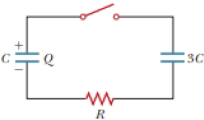
Concept explainers
A charge Q is placed on a capacitor of capacitance C. The capacitor is connected into the circuit shown in Figure P26.37, with an open switch, a resistor, and an initially uncharged capacitor of capacitance 3C. The switch is then closed, and the circuit comes to equilibrium. In terms of Q and C, find (a) the final potential difference between the plates of each capacitor, (b) the charge on each capacitor, and (c) the final energy stored in each capacitor. (d) Find the internal energy appearing in the resistor.
Figure P26.37

(a)
Answer to Problem 27.63AP
Explanation of Solution
Given information: The value of capacitor into the circuit is
Explanation:
Formula to calculate the equivalent capacitance of the system when they are connected in parallel.
Here,
Substitute
Thus, the equivalent capacitance of the system when they are connected in parallel is
Formula to calculate the final potential difference between the plates of each capacitor.
Here,
Substitute
Thus, the final potential difference between the plates of each capacitor is
Conclusion:
Therefore, the final potential difference between the plates of each capacitor is
(b)
Answer to Problem 27.63AP
Explanation of Solution
Given information: The value of capacitor into the circuit is
Explanation:
Formula to calculate the charge placed on a capacitor
Here,
Substitute
Thus, the charge placed on a capacitor
Formula to calculate the charge placed on a capacitor
Here,
Substitute
Thus, the charge placed on a capacitor
Conclusion:
Therefore, the charge on capacitor
(c)
Answer to Problem 27.63AP
Explanation of Solution
Given information: The value of capacitor into the circuit is
Explanation:
Formula to calculate the energy stored in the capacitor
Here,
Substitute
Thus, the energy stored in the capacitor
Formula to calculate the energy stored in the capacitor
Here,
Substitute
Thus, the energy stored in the capacitor
Conclusion:
Therefore, the energy stored in the capacitor
(d)
Answer to Problem 27.63AP
Explanation of Solution
Given information: The value of capacitor into the circuit is
Explanation:
Write the expression for the original energy in the resistor.
Here,
Formula to calculate the internal energy appearing in the resistor.
Here,
Substitute
Thus, the internal energy appearing in the resistor is
Conclusion:
Therefore, the internal energy appearing in the resistor is
Want to see more full solutions like this?
Chapter 27 Solutions
EBK PHYSICS FOR SCIENTISTS AND ENGINEER
- A person is running a temperature of 41.0°C. What is the equivalent temperature on the Fahrenheit scale? (Enter your answer to at least three significant figures.) °Farrow_forwardWhat is the period of a rock of mass 2.0kg tied to the end of a spring 0.625m long string that hangs in a doorway and has an elastic constant of 40N/m?arrow_forwardGive an example of friction speeding up an object.arrow_forward
- Which is the higher temperature? (Assume temperatures to be exact numbers.) (a) 272°C or 272°F? 272°C 272°F They are the same temperature. (b) 200°C or 368°F? 200°C 368°F They are the same temperature.arrow_forwardWhat is the direction of a force vector given by ~v = −6Nˆi − 8Nˆj?arrow_forwardWhat can be said of the position vector of an object far from any influences on its motion?arrow_forward
- ་ Consider a ball sliding down a ramp as shown above. The ball is already in motion at the position 1. Which direction best approximates the direction of acceleration vector a when the object is at position 2?arrow_forwardPlease solve and answer the question correctly please. Thank you!!arrow_forwardPlease solve and answer the question correctly please. Thank you!!arrow_forward
 Physics for Scientists and EngineersPhysicsISBN:9781337553278Author:Raymond A. Serway, John W. JewettPublisher:Cengage Learning
Physics for Scientists and EngineersPhysicsISBN:9781337553278Author:Raymond A. Serway, John W. JewettPublisher:Cengage Learning Physics for Scientists and Engineers with Modern ...PhysicsISBN:9781337553292Author:Raymond A. Serway, John W. JewettPublisher:Cengage Learning
Physics for Scientists and Engineers with Modern ...PhysicsISBN:9781337553292Author:Raymond A. Serway, John W. JewettPublisher:Cengage Learning Principles of Physics: A Calculus-Based TextPhysicsISBN:9781133104261Author:Raymond A. Serway, John W. JewettPublisher:Cengage Learning
Principles of Physics: A Calculus-Based TextPhysicsISBN:9781133104261Author:Raymond A. Serway, John W. JewettPublisher:Cengage Learning Physics for Scientists and Engineers: Foundations...PhysicsISBN:9781133939146Author:Katz, Debora M.Publisher:Cengage Learning
Physics for Scientists and Engineers: Foundations...PhysicsISBN:9781133939146Author:Katz, Debora M.Publisher:Cengage Learning Physics for Scientists and Engineers, Technology ...PhysicsISBN:9781305116399Author:Raymond A. Serway, John W. JewettPublisher:Cengage Learning
Physics for Scientists and Engineers, Technology ...PhysicsISBN:9781305116399Author:Raymond A. Serway, John W. JewettPublisher:Cengage Learning College PhysicsPhysicsISBN:9781285737027Author:Raymond A. Serway, Chris VuillePublisher:Cengage Learning
College PhysicsPhysicsISBN:9781285737027Author:Raymond A. Serway, Chris VuillePublisher:Cengage Learning





